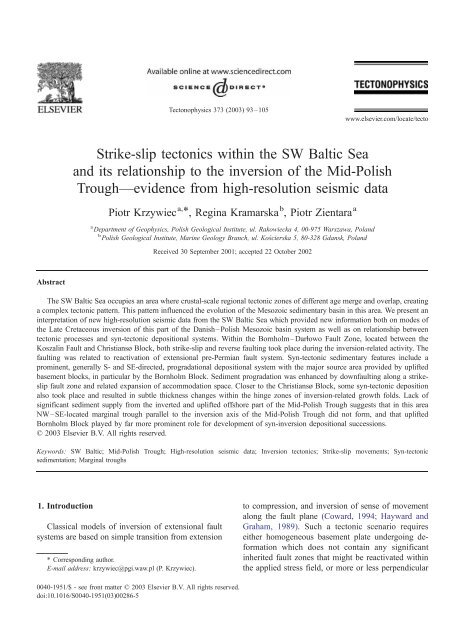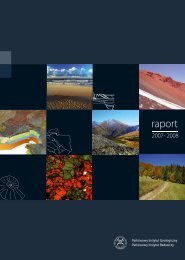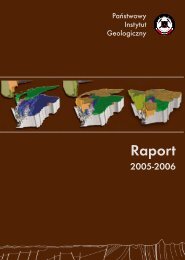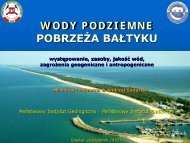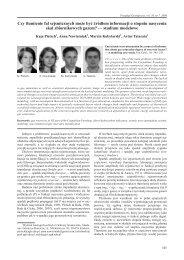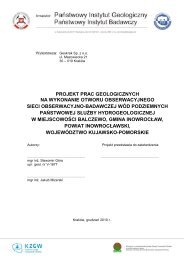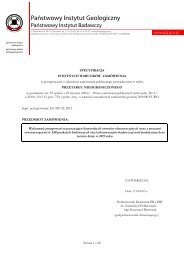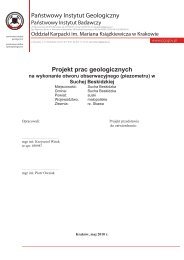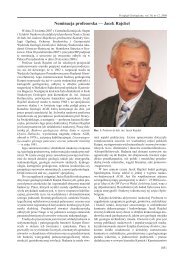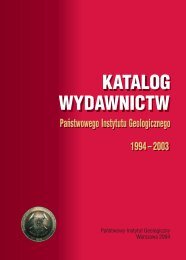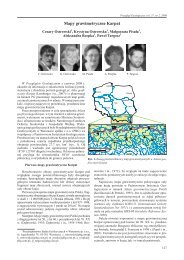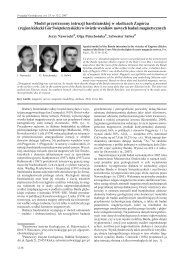Strike-slip tectonics within the SW Baltic Sea and its relationship to ...
Strike-slip tectonics within the SW Baltic Sea and its relationship to ...
Strike-slip tectonics within the SW Baltic Sea and its relationship to ...
You also want an ePaper? Increase the reach of your titles
YUMPU automatically turns print PDFs into web optimized ePapers that Google loves.
Abstract<br />
<strong>Strike</strong>-<strong>slip</strong> <strong>tec<strong>to</strong>nics</strong> <strong>within</strong> <strong>the</strong> <strong>SW</strong> <strong>Baltic</strong> <strong>Sea</strong><br />
<strong>and</strong> <strong>its</strong> <strong>relationship</strong> <strong>to</strong> <strong>the</strong> inversion of <strong>the</strong> Mid-Polish<br />
Trough—evidence from high-resolution seismic data<br />
Piotr Krzywiec a, *, Regina Kramarska b , Piotr Zientara a<br />
a Department of Geophysics, Polish Geological Institute, ul. Rakowiecka 4, 00-975 Warszawa, Pol<strong>and</strong><br />
b Polish Geological Institute, Marine Geology Branch, ul. Kos´cierska 5, 80-328 Gdansk, Pol<strong>and</strong><br />
Received 30 September 2001; accepted 22 Oc<strong>to</strong>ber 2002<br />
The <strong>SW</strong> <strong>Baltic</strong> <strong>Sea</strong> occupies an area where crustal-scale regional tec<strong>to</strong>nic zones of different age merge <strong>and</strong> overlap, creating<br />
a complex tec<strong>to</strong>nic pattern. This pattern influenced <strong>the</strong> evolution of <strong>the</strong> Mesozoic sedimentary basin in this area. We present an<br />
interpretation of new high-resolution seismic data from <strong>the</strong> <strong>SW</strong> <strong>Baltic</strong> <strong>Sea</strong> which provided new information both on modes of<br />
<strong>the</strong> Late Cretaceous inversion of this part of <strong>the</strong> Danish–Polish Mesozoic basin system as well as on <strong>relationship</strong> between<br />
tec<strong>to</strong>nic processes <strong>and</strong> syn-tec<strong>to</strong>nic depositional systems. Within <strong>the</strong> Bornholm–Darlowo Fault Zone, located between <strong>the</strong><br />
Koszalin Fault <strong>and</strong> Christiansø Block, both strike-<strong>slip</strong> <strong>and</strong> reverse faulting <strong>to</strong>ok place during <strong>the</strong> inversion-related activity. The<br />
faulting was related <strong>to</strong> reactivation of extensional pre-Permian fault system. Syn-tec<strong>to</strong>nic sedimentary features include a<br />
prominent, generally S- <strong>and</strong> SE-directed, progradational depositional system with <strong>the</strong> major source area provided by uplifted<br />
basement blocks, in particular by <strong>the</strong> Bornholm Block. Sediment progradation was enhanced by downfaulting along a strike<strong>slip</strong><br />
fault zone <strong>and</strong> related expansion of accommodation space. Closer <strong>to</strong> <strong>the</strong> Christiansø Block, some syn-tec<strong>to</strong>nic deposition<br />
also <strong>to</strong>ok place <strong>and</strong> resulted in subtle thickness changes <strong>within</strong> <strong>the</strong> hinge zones of inversion-related growth folds. Lack of<br />
significant sediment supply from <strong>the</strong> inverted <strong>and</strong> uplifted offshore part of <strong>the</strong> Mid-Polish Trough suggests that in this area<br />
NW–SE-located marginal trough parallel <strong>to</strong> <strong>the</strong> inversion axis of <strong>the</strong> Mid-Polish Trough did not form, <strong>and</strong> that uplifted<br />
Bornholm Block played by far more prominent role for development of syn-inversion depositional successions.<br />
D 2003 Elsevier B.V. All rights reserved.<br />
Keywords: <strong>SW</strong> <strong>Baltic</strong>; Mid-Polish Trough; High-resolution seismic data; Inversion <strong>tec<strong>to</strong>nics</strong>; <strong>Strike</strong>-<strong>slip</strong> movements; Syn-tec<strong>to</strong>nic<br />
sedimentation; Marginal troughs<br />
1. Introduction<br />
Classical models of inversion of extensional fault<br />
systems are based on simple transition from extension<br />
* Corresponding author.<br />
E-mail address: krzywiec@pgi.waw.pl (P. Krzywiec).<br />
Tec<strong>to</strong>nophysics 373 (2003) 93–105<br />
0040-1951/$ - see front matter D 2003 Elsevier B.V. All rights reserved.<br />
doi:10.1016/S0040-1951(03)00286-5<br />
www.elsevier.com/locate/tec<strong>to</strong><br />
<strong>to</strong> compression, <strong>and</strong> inversion of sense of movement<br />
along <strong>the</strong> fault plane (Coward, 1994; Hayward <strong>and</strong><br />
Graham, 1989). Such a tec<strong>to</strong>nic scenario requires<br />
ei<strong>the</strong>r homogeneous basement plate undergoing deformation<br />
which does not contain any significant<br />
inherited fault zones that might be reactivated <strong>within</strong><br />
<strong>the</strong> applied stress field, or more or less perpendicular
94<br />
orientation of inherited fault zones <strong>to</strong> <strong>the</strong> extensional<br />
<strong>and</strong> compressional stress fields. Regional obliquity of<br />
inherited basement faults <strong>and</strong> <strong>the</strong> stress field often<br />
results in formation of transverse fault zones during<br />
rifting <strong>and</strong> subsequent basin development (Cartwright,<br />
1987), as well as strike-<strong>slip</strong> movements <strong>and</strong> development<br />
of positive flower structures during inversion<br />
(Harding, 1985; Woodcock <strong>and</strong> Schubert, 1994;<br />
Lihou <strong>and</strong> Allen, 1996). Within hinge zones of<br />
inversion-related folds, thickness reductions of syninversion<br />
depos<strong>its</strong> accompanied by localised progradational<br />
pattern are often observed <strong>and</strong> indicate syndepositional<br />
tec<strong>to</strong>nic activity (Cartwright, 1989).<br />
High-resolution seismics is a very powerful research<br />
<strong>to</strong>ol in studies of <strong>the</strong> Cenozoic evolution of<br />
<strong>the</strong> offshore areas, as is shown, e.g. by recent studies<br />
of Cenozoic his<strong>to</strong>ry of <strong>the</strong> Danish North <strong>Sea</strong>. In this<br />
area, shallow seismic profiles imaged both detailed<br />
depositional architecture of Cenozoic depos<strong>its</strong><br />
(Michelsen et al., 1998; Clausen et al., 1999), often<br />
deformed by tec<strong>to</strong>nic (e.g. glacitec<strong>to</strong>nic) <strong>and</strong> erosional<br />
processes (Huuse <strong>and</strong> Lykke-Andersen,<br />
2000a,b), as well as <strong>the</strong>ir immediate substratum<br />
(Huuse, 1999). Regional coverage of shallow seismic<br />
data combined with well information <strong>and</strong> petroleum<br />
seismic data provided a database allowing for construction<br />
of a regional model of Cenozoic evolution<br />
of this large offshore area (Clausen <strong>and</strong> Huuse, 1999;<br />
Huuse et al., 2001).<br />
New offshore high-resolution seismic data from <strong>the</strong><br />
sou<strong>the</strong>rn <strong>Baltic</strong> <strong>Sea</strong> are presented here. This data set<br />
documents modes of <strong>the</strong> Late Cretaceous inversion<br />
<strong>tec<strong>to</strong>nics</strong> <strong>within</strong> <strong>the</strong> wide zone stretching between <strong>the</strong><br />
isl<strong>and</strong> of Borholm <strong>and</strong> <strong>the</strong> Polish coast, in particular<br />
large amount of strike-<strong>slip</strong> deformations related <strong>to</strong> <strong>the</strong><br />
inversion. The interpretation has led <strong>to</strong> an updated <strong>and</strong><br />
refined tec<strong>to</strong>nic map of <strong>the</strong> <strong>SW</strong> <strong>Baltic</strong> <strong>Sea</strong>.<br />
2. Geological setting<br />
The <strong>SW</strong> <strong>Baltic</strong> <strong>Sea</strong> forms part of a very complicated<br />
area where several important regional tec<strong>to</strong>nic zones<br />
<strong>and</strong> lines overlap <strong>and</strong> merge, including Sorgenfrei–<br />
Tornquist Zone (STZ), Teisseyre–Tornquist Zone<br />
(TTZ) <strong>and</strong> <strong>the</strong> Caledonian deformation front (Fig. 1;<br />
Pharaoh, 1999 <strong>and</strong> references <strong>the</strong>rein). Research projects<br />
including deep seismic reflection profiling have<br />
P. Krzywiec et al. / Tec<strong>to</strong>nophysics 373 (2003) 93–105<br />
Fig. 1. Location of <strong>the</strong> study area (rectangle) <strong>and</strong> <strong>its</strong> <strong>relationship</strong> <strong>to</strong><br />
<strong>the</strong> major crustal features of <strong>the</strong> North Europe, including <strong>the</strong><br />
Precambrian East European Platform, <strong>the</strong> Palaeozoic West European<br />
Platform, <strong>the</strong> Caledonian, Variscan <strong>and</strong> Carpathian orogenic fronts,<br />
<strong>the</strong> Tornquist–Teisseyre Zone (TTZ) <strong>and</strong> <strong>the</strong> Sorgenfrei–Tornquist<br />
Zone (STZ) (after Pharaoh, 1999, simplified <strong>and</strong> modified).<br />
been completed in this area (EUGENO-S Working<br />
Group, 1988; BABEL Working Group, 1991; Meissner<br />
et al., 1994), <strong>and</strong> numerous alternative hypo<strong>the</strong>ses<br />
have been formulated on various aspects of <strong>its</strong> presentday<br />
crustal structure <strong>and</strong> geodynamic evolution (e.g.<br />
Pegrum, 1984; Tanner <strong>and</strong> Meissner, 1996; Ber<strong>the</strong>lsen,<br />
1998). However, even <strong>the</strong> basic features that<br />
characterise <strong>SW</strong> <strong>Baltic</strong> <strong>Sea</strong> <strong>and</strong> surrounding areas such<br />
as <strong>the</strong> extent of <strong>Baltic</strong>a <strong>and</strong> Avalonia blocks, existence<br />
of <strong>the</strong> Trans-European Fault, <strong>and</strong> <strong>the</strong> presence <strong>and</strong><br />
exact location of Caledonian deformation front are still<br />
discussed <strong>and</strong> no consensus has been reached yet<br />
(Thybo, 1997, 2001; Franke, 1990; Dadlez, 2000;<br />
Lassen et al., 2001; McCann <strong>and</strong> Krawczyk, 2001).<br />
During Permian through Cretaceous times several<br />
sedimentary basins <strong>and</strong> sub-basins of <strong>the</strong> so-called<br />
Peri-Tethys domain developed in Western <strong>and</strong> Central<br />
Europe due <strong>to</strong> post-orogenic destruction of <strong>the</strong> Variscan<br />
forel<strong>and</strong> initiated by Late Carboniferous wrenching<br />
<strong>and</strong> strike-<strong>slip</strong> movements (Brochwicz-Lewiński<br />
et al., 1984; Ziegler, 1990; van Wees et al., 2000).<br />
Significant subsidence <strong>and</strong> deposition <strong>to</strong>ok place<br />
along <strong>the</strong> Sorgenfrei–Tornquist Zone in Scania <strong>and</strong>
Kattegat (Norling <strong>and</strong> Bergstrom, 1987; Mogensen<br />
<strong>and</strong> Jensen, 1994; Michelsen, 1997) <strong>and</strong> <strong>the</strong> Teisseyre–Tornquist<br />
Zone (TTZ) in Pol<strong>and</strong>. Along <strong>the</strong><br />
TTZ, <strong>the</strong> Polish Basin developed with <strong>its</strong> mostly<br />
subsided axial part, Mid-Polish Trough (MPT; Poz˙aryski<br />
<strong>and</strong> Brochwicz-Lewiński, 1978; Dadlez et al.,<br />
1995; van Wees et al., 2000). During Late Cretaceous–Cenozoic<br />
inversion of <strong>the</strong> Peri-Tethyan epicontinental<br />
sedimentary basins, various faults <strong>and</strong><br />
fault zones have been reactivated <strong>and</strong> gave rise <strong>to</strong><br />
<strong>the</strong> development of <strong>the</strong> inversion structures (e.g.<br />
Ziegler, 1989; Ziegler et al., 1995; Roure <strong>and</strong> Colletta,<br />
1996). In a regional sense, spreading <strong>within</strong> <strong>the</strong><br />
Atlantic domain, <strong>and</strong> Alpine–Carpathian collision<br />
have generated compressional stresses that were transferred<br />
in<strong>to</strong> <strong>the</strong> forel<strong>and</strong> plate <strong>and</strong> resulted in reactivation<br />
<strong>and</strong> inversion of faults responsible for <strong>the</strong><br />
formation of Mesozoic sedimentary basins. During<br />
inversion of Peri-Tethyan domain also <strong>the</strong> sedimentary<br />
basins developed along <strong>the</strong> STZ <strong>and</strong> TTZ underwent<br />
inversion (e.g. Poz˙aryski <strong>and</strong> Brochwicz-Lewiński,<br />
1978; Vejbæk <strong>and</strong> Andersen, 1987; Mogensen <strong>and</strong><br />
Jensen, 1994; Dadlez, 1997; Dronkers <strong>and</strong> Mrozek,<br />
1991; Krzywiec, 2000, 2002a).<br />
A complicated regional stress field generated by<br />
<strong>the</strong> Atlantic spreading <strong>and</strong> <strong>the</strong> Alpine–Carpathian<br />
collision superimposed on equally complicated regional<br />
fault pattern related <strong>to</strong> both pre-Permian (Variscan<br />
<strong>and</strong> Caledonian) tec<strong>to</strong>nic events <strong>and</strong> Permian–<br />
Mesozoic basin development, resulted in various<br />
modes <strong>and</strong> amounts of inversion. During <strong>the</strong> Late<br />
Cretaceous inversion of <strong>the</strong> MPT, including <strong>its</strong> offshore<br />
part located in <strong>the</strong> <strong>SW</strong> <strong>Baltic</strong> <strong>Sea</strong>, various<br />
inversion-related structures developed like reverse<br />
faults <strong>and</strong> associated fault-propagation folds, <strong>and</strong><br />
NW–SE- or SE–NW-oriented flower structures induced<br />
by strike-<strong>slip</strong> movements (Poz˙aryski, 1977;<br />
An<strong>to</strong>nowicz et al., 1994; Strzetelski et al., 1995;<br />
Schlüter et al., 1997; Krzywiec, 2000, 2002a).<br />
The onshore NW part of <strong>the</strong> MPT, located in<br />
immediate vicinity of <strong>the</strong> study area, is built of several<br />
crustal blocks related <strong>to</strong> Palaeozoic <strong>and</strong> Precambrian<br />
platforms (Znosko, 1979; Guterch et al., 1994;<br />
Dadlez, 1997, 2000; Petecki, 2001; Królikowski <strong>and</strong><br />
Petecki, 1997). The MPT can be traced <strong>to</strong>wards <strong>the</strong><br />
area <strong>SW</strong> of Bornholm (Fig. 2). In this region, <strong>the</strong><br />
NW–SE trending Kamien Pomorski–Adler <strong>and</strong> Koszalin<br />
faults form NE <strong>and</strong> <strong>SW</strong> borders of <strong>the</strong> inverted<br />
P. Krzywiec et al. / Tec<strong>to</strong>nophysics 373 (2003) 93–105 95<br />
Fig. 2. Tec<strong>to</strong>nic map of <strong>the</strong> Bornholm–Darlowo Fault Zone<br />
(according <strong>to</strong> Kramarska et al., 1999, modified <strong>and</strong> supplemented<br />
using results of Deeks <strong>and</strong> Thomas, 1995; Vejbæk,<br />
1985; Vejbæk et al., 1994, <strong>and</strong> unpublished Petrobaltic maps).<br />
Thin lines—shallow high-resolution seismic lines, thick lines<br />
with numbers—location of seismic examples with appropriate<br />
figure numbers.<br />
MPT, respectively (Fig. 2; Dadlez <strong>and</strong> Mlynarski,<br />
1967; Dadlez, 1974, 1976; Poz˙aryski et al., 1978;<br />
Liboriussen et al., 1987; Poz˙aryski <strong>and</strong> Witkowski,<br />
1990; Thomas et al., 1993; Dadlez et al., 1995;<br />
Kramarska et al., 1999). These two fault zones form<br />
an extensional (possibly partly transtensional) fault<br />
system inverted in a compressional (possibly partly<br />
transpressional) tec<strong>to</strong>nic regime. Asymmetric faultpropagation<br />
folds developed <strong>within</strong> <strong>the</strong> Mesozoic<br />
basin infill above major inversion-related reverse<br />
faults <strong>within</strong> <strong>the</strong> pre-Zechstein basement (Schlüter et<br />
al., 1997; Krzywiec, 2000, 2002a; Dadlez, 2001). Itis<br />
not possible <strong>to</strong> precisely determine <strong>the</strong> onset of<br />
inversion in this part of <strong>the</strong> MPT due <strong>to</strong> significant<br />
uplift of inversion anticlines, related deep erosion <strong>and</strong><br />
lack of preserved syn-inversion depos<strong>its</strong>.<br />
In <strong>the</strong> transition area between STZ <strong>and</strong> TTZ,<br />
several tec<strong>to</strong>nic un<strong>its</strong> are distinguished including <strong>the</strong><br />
NW part of <strong>the</strong> MPT, Svaneke Trough, Bornholm
96<br />
Block, Christiansø Block; Rønne Graben <strong>and</strong> Arnager<br />
Block (Fig. 2; Vejbæk, 1985; Vejbæk et al., 1994;<br />
Deeks <strong>and</strong> Thomas, 1995).<br />
During <strong>the</strong> Mesozoic, <strong>within</strong> <strong>the</strong> transition area<br />
between <strong>the</strong> STZ <strong>and</strong> <strong>the</strong> TTZ comprising <strong>the</strong> presentday<br />
Bornholm isl<strong>and</strong> <strong>and</strong> <strong>its</strong> surroundings (Fig. 2),<br />
Triassic <strong>to</strong> Jurassic <strong>and</strong> Lower Cretaceous deposition<br />
<strong>to</strong>ok place due <strong>to</strong> extensional phase of basin development<br />
(Gravesen et al., 1982; Schlüter et al., 1997).<br />
<strong>Strike</strong>-<strong>slip</strong> movements resulted in formation of pullapart<br />
basins like <strong>the</strong> Rønne <strong>and</strong> <strong>the</strong> Arnager Grabens<br />
(Liboriussen et al., 1987; Vejbæk, 1985; Ziegler,<br />
1990; Thomas et al., 1993; Deeks <strong>and</strong> Thomas,<br />
1995). Remnants of <strong>the</strong> Mesozoic sedimentary cover<br />
have been drilled by exploration wells (Rempel, 1992;<br />
Vejbæk et al., 1994) <strong>and</strong> are accessible in limited<br />
outcrops on Bornholm (Gravesen et al., 1982). They<br />
represent Triassic continental rift sediments, Lower<br />
Jurassic lacustrine <strong>and</strong> deltaic depos<strong>its</strong> related <strong>to</strong> basin<br />
expansion, Mid Jurassic regressive depos<strong>its</strong>, <strong>and</strong><br />
Lower Cretaceous transgressive depos<strong>its</strong> related <strong>to</strong><br />
<strong>the</strong> next phase of basin expansion (Gravesen et al.,<br />
1982). Late Cretaceous inversion of <strong>the</strong> entire Danish–Polish<br />
basin system coupled with relatively rigid<br />
behaviour of uplifted Bornholm Block resulted in<br />
localized deviations of regional stress trajec<strong>to</strong>ries<br />
<strong>and</strong> related complicated tec<strong>to</strong>nic movements around<br />
this basement pop-up structure, which represents a<br />
large-scale overstep in <strong>the</strong> strike-<strong>slip</strong> fault system<br />
between <strong>the</strong> STZ <strong>and</strong> <strong>the</strong> TTZ (cf. Deeks <strong>and</strong> Thomas,<br />
1995). Inversion-related uplift of particular basement<br />
blocks led <strong>to</strong> <strong>the</strong>ir localised erosion <strong>and</strong> formation of<br />
syn-tec<strong>to</strong>nic depos<strong>its</strong> that were prograding from<br />
uplifted blocks <strong>to</strong>wards local depocentres (Deeks<br />
<strong>and</strong> Thomas, 1995).<br />
3. Seismic data acquisition <strong>and</strong> processing<br />
High-resolution seismic data from <strong>the</strong> <strong>SW</strong> <strong>Baltic</strong><br />
<strong>Sea</strong> were acquired <strong>within</strong> <strong>the</strong> Polish terri<strong>to</strong>rial waters<br />
<strong>and</strong> economic zone, <strong>and</strong> partly <strong>within</strong> <strong>the</strong> adjacent<br />
German, Danish <strong>and</strong> Swedish economic zones (Kramarska<br />
et al., 1999; Figs. 2 <strong>and</strong> 3). Location of<br />
acquired seismic profiles in <strong>the</strong> study area was mostly<br />
NW–SE <strong>and</strong> <strong>SW</strong>–NE, <strong>and</strong> was related <strong>to</strong> trends of<br />
major tec<strong>to</strong>nic un<strong>its</strong> (Fig. 3). Three field campaigns<br />
were organised in years 1996, 1997 <strong>and</strong> 1998 using<br />
P. Krzywiec et al. / Tec<strong>to</strong>nophysics 373 (2003) 93–105<br />
Fig. 3. Location of <strong>the</strong> study area <strong>and</strong> shallow high-resolution<br />
seismic profiles (thin lines) acquired <strong>within</strong> <strong>the</strong> <strong>SW</strong> <strong>Baltic</strong> <strong>Sea</strong> (after<br />
Kramarska et al., 1999). A–AV<strong>and</strong> B–BV-parts of <strong>the</strong> shallow highresolution<br />
seismic profiles crossing <strong>the</strong> Bornholm–Darlowo Fault<br />
Zone shown on Fig. 4, dashed lines—terri<strong>to</strong>rial borders, dots—<br />
wells (A8, K1, K5, K9, L2, Stina-1, Pernille-1 <strong>and</strong> Yoldia-1 are<br />
deep petroleum wells, OT-1, W-3, W-13 <strong>and</strong> 2NE are shallow<br />
car<strong>to</strong>graphic wells).<br />
research vessel ‘‘Dr Lubecki’’ provided by <strong>the</strong> Maritime<br />
Institute from Gdansk. The Ne<strong>the</strong>rl<strong>and</strong>s Institute<br />
of Applied Geoscience (TNO) provided seismic field<br />
equipment. Navigation data were supplied by DGPS<br />
vessel location system. The Texas Instruments 10W<br />
sleevegun was deployed as a source of seismic waves,<br />
<strong>and</strong> <strong>the</strong> Prakla-Seismos 12 channel streamer was used<br />
for seismic data recording. The length of each channel<br />
was 12.4 m, <strong>and</strong> distance between channels was 12.5<br />
m. The seismic recording system consisted of MGS<br />
12-channel Marine Data Acquisition System, which<br />
provided sixfold coverage. Sampling rate for <strong>the</strong><br />
majority of acquired seismic profiles was set <strong>to</strong> 0.5<br />
ms <strong>and</strong> recording time was ei<strong>the</strong>r 0.8 or 1 s.<br />
Seismic data acquired during 1996 cruise were<br />
processed at <strong>the</strong> Ne<strong>the</strong>rl<strong>and</strong>s Institute of Applied Geoscience<br />
(TNO) using ProMAX processing software<br />
(L<strong>and</strong>mark Graphics), <strong>and</strong> seismic data acquired dur-
ing 1997 <strong>and</strong> 1998 cruises were processed at <strong>the</strong><br />
Department of Geophysics, Polish Geological Institute<br />
using FOCUS software. The velocity analysis was<br />
completed at about each 500 CDP, i.e. for about each<br />
3 km. After NMO <strong>and</strong> data stack, post-stack predictive<br />
deconvolution was applied in order <strong>to</strong> remove multiple<br />
reflections related <strong>to</strong> a sea bot<strong>to</strong>m. Migration was not<br />
applied <strong>to</strong> <strong>the</strong> acquired data, as <strong>its</strong> possible effect would<br />
not significantly enhance data quality.<br />
Data quality could be described as moderate <strong>to</strong><br />
very good. Lowest quality characterises areas located<br />
close <strong>to</strong> <strong>the</strong> coastline <strong>and</strong> with thick gravel cover on<br />
sea bot<strong>to</strong>m. Within <strong>the</strong> Bornholm–Darlowo Fault<br />
Zone data quality is good <strong>to</strong> very good, with vertical<br />
resolution in order of a few metres. For <strong>the</strong> entire<br />
acquired seismic data set a major problem during<br />
data interpretation was <strong>the</strong> presence of strong multiple<br />
events related <strong>to</strong> a sea bot<strong>to</strong>m, but for data from<br />
<strong>the</strong> Bornholm–Darlowo Fault Zone, this event did<br />
not significantly influence accuracy of a completed<br />
interpretation.<br />
4. Interpretation of <strong>the</strong> seismic data<br />
The processed seismic data were loaded in<strong>to</strong> <strong>the</strong><br />
L<strong>and</strong>mark Graphics interpretation system, <strong>to</strong>ge<strong>the</strong>r<br />
with available well data that included stratigraphy<br />
<strong>and</strong> time–depth data from selected petroleum wells<br />
drilled by <strong>the</strong> Petrobaltic oil company (Rempel, 1992;<br />
Schlüter et al., 1997). Additionally, selected Petrobaltic<br />
seismic data were also available during interpretation<br />
of shallow high-resolution seismic data. However,<br />
<strong>the</strong>y were available for most western <strong>and</strong> eastern<br />
parts of <strong>the</strong> S <strong>Baltic</strong> <strong>Sea</strong> only; in particular, no<br />
petroleum seismic <strong>and</strong> well data were available from<br />
<strong>the</strong> Bornholm–Darlowo Fault Zone.<br />
A large number of kilometres of high-resolution<br />
seismic data have been acquired. However, due <strong>to</strong> <strong>the</strong><br />
large area surveyed (line spacing in an order of 15–20<br />
km or larger), acquired data provided only general<br />
insight in<strong>to</strong> <strong>the</strong> complicated sedimentary architecture<br />
<strong>and</strong> tec<strong>to</strong>nic pattern of post-Palaeozoic sedimentary<br />
cover. Earlier published maps were based on seismic<br />
surveys with limited coverage due <strong>to</strong> complex pattern<br />
of <strong>the</strong> state boundaries; in particular, very limited data<br />
were accessible for <strong>the</strong> area between Bornholm <strong>and</strong><br />
<strong>the</strong> Polish coast.<br />
P. Krzywiec et al. / Tec<strong>to</strong>nophysics 373 (2003) 93–105 97<br />
In 1970–1980 extensive shallow seismic profiling<br />
programme was completed <strong>within</strong> <strong>the</strong> sou<strong>the</strong>rn <strong>Baltic</strong><br />
<strong>Sea</strong>. During this experiment both single- <strong>and</strong> multichannel<br />
seismic profiles have been acquired (Sviridov<br />
et al., 1995). Some of multichannel profiles, located <strong>to</strong><br />
<strong>the</strong> S <strong>and</strong> SE from <strong>the</strong> Bornholm, slightly overlap with<br />
seismic lines described in this paper <strong>and</strong> could be<br />
correlated with <strong>the</strong>m. Interpretation of <strong>the</strong> high-resolution<br />
seismic data was also supported by <strong>the</strong> published<br />
geological maps of <strong>the</strong> study area that were<br />
constructed using petroleum seismic data (Vejbæk,<br />
1985; Vejbæk et al., 1994; Deeks <strong>and</strong> Thomas,<br />
1995; Schlüter et al., 1997). Additionally, selected<br />
unpublished Petrobalic seismic structural maps were<br />
also used. This allowed for preparation of a much<br />
more detailed tec<strong>to</strong>nic map for this part of <strong>the</strong> sou<strong>the</strong>rn<br />
<strong>Baltic</strong> <strong>Sea</strong> (Fig. 2).<br />
In <strong>the</strong> area between Bornholm <strong>and</strong> onshore Pol<strong>and</strong>,<br />
it is likely that a fairly complete Upper Cretaceous<br />
succession is present, <strong>and</strong> that Maastrichtian depos<strong>its</strong><br />
crop out on <strong>the</strong> sub-Cenozoic surface (Poz˙aryski et al.,<br />
1978; Jaskowiak-Schoeneich <strong>and</strong> Poz˙aryski, 1979;<br />
Poz˙aryski <strong>and</strong> Witkowski, 1990; Us´cinowicz <strong>and</strong><br />
Zachowicz, 1993). Cretaceous depos<strong>its</strong> most probably<br />
rest mostly on Silurian basement. Only close <strong>the</strong><br />
Polish coastline, in relatively narrow belt, Permian,<br />
Triassic <strong>and</strong> Jurassic depos<strong>its</strong> are also present beneath<br />
<strong>the</strong> Cretaceous cover (Kramarska et al., 1999). Due <strong>to</strong><br />
<strong>the</strong> lack of deep wells <strong>within</strong> <strong>the</strong> Bornholm–Darlowo<br />
Fault Zone, location of <strong>the</strong> boundary between Palaeozoic<br />
<strong>and</strong> Mesozoic complexes is based on longdistance<br />
correlation with offshore <strong>and</strong> onshore wells<br />
(Fig. 3), very often across large fault zones, <strong>and</strong><br />
should <strong>the</strong>refore be regarded as tentative.<br />
In <strong>the</strong> area between Bornholm <strong>to</strong> <strong>the</strong> NW <strong>and</strong> <strong>the</strong><br />
Polish coast (vicinity of Darlowo city) <strong>to</strong> <strong>the</strong> SE, <strong>and</strong><br />
<strong>the</strong> Koszalin Fault <strong>to</strong> <strong>the</strong> <strong>SW</strong> <strong>and</strong> <strong>the</strong> Christiansø Block<br />
<strong>to</strong> <strong>the</strong> NE, a wide zone of reverse <strong>and</strong> strike-<strong>slip</strong> faults<br />
related <strong>to</strong> inversion of <strong>the</strong> Danish–Polish Basin has<br />
been detected using high-resolution seismic data (Kramarska<br />
et al., 1999). This zone forms a direct continuation<br />
of <strong>the</strong> tec<strong>to</strong>nic zone known from <strong>the</strong> immediate<br />
<strong>SW</strong> surroundings of Bornholm including <strong>the</strong> Bornholm<br />
Block <strong>and</strong> <strong>the</strong> Svaneke Trough (Vejbæk et al., 1994;<br />
Deeks <strong>and</strong> Thomas, 1995; Sviridov et al., 1995). Itis<br />
proposed hereby <strong>to</strong> name this zone <strong>the</strong> Bornholm–<br />
Darlowo Fault Zone (Fig. 2). Faults are most prominent<br />
in NW part of <strong>the</strong> Bornholm–Darlowo Fault Zone;
98<br />
<strong>to</strong>wards <strong>the</strong> Polish coast <strong>the</strong>y become more diffuse <strong>and</strong><br />
die out. Within <strong>the</strong> onshore area no traces of this fault<br />
zone have been identified (Dadlez <strong>and</strong> Mlynarski,<br />
1967; Dadlez, 1974, 1976, 1990; Poz˙aryski et al.,<br />
1978; Poz˙aryski <strong>and</strong> Witkowski, 1990).<br />
Two regional shallow high-resolution seismic profiles<br />
show <strong>the</strong> general sedimentary <strong>and</strong> tec<strong>to</strong>nic pattern<br />
for <strong>the</strong> Upper Cretaceous sedimentary cover <strong>and</strong><br />
<strong>the</strong>ir Palaeozoic (most probably Silurian) basement<br />
(Fig. 4). These profiles cross Bornholm–Darlowo<br />
Fault Zone <strong>and</strong> are located between <strong>the</strong> inverted<br />
MPT <strong>to</strong> <strong>the</strong> <strong>SW</strong> (bordered by <strong>the</strong> Koszalin Fault),<br />
<strong>and</strong> <strong>the</strong> uplifted Christiansø Block <strong>to</strong> <strong>the</strong> NE (Figs. 2<br />
<strong>and</strong> 3). Within <strong>the</strong> Upper Cretaceous succession,<br />
angular unconformities, reverse faults <strong>and</strong> related<br />
folds can be observed. The degree of complexity is<br />
clearly higher <strong>to</strong>wards <strong>the</strong> NW, <strong>to</strong>wards Bornholm<br />
(profile B), while <strong>to</strong>wards <strong>the</strong> SE (profile A), a less<br />
complex tec<strong>to</strong>nic pattern can be observed. Such diversity<br />
of <strong>the</strong> observed tec<strong>to</strong>nic pattern was caused by<br />
more intense Late Cretaceous tec<strong>to</strong>nic movements in<br />
immediate vicinity of <strong>the</strong> present-day Bornholm area,<br />
<strong>and</strong> less intense tec<strong>to</strong>nic activity closer <strong>to</strong> <strong>the</strong> presentday<br />
Polish coastline. In Figs. 5 <strong>and</strong> 6 enlarged parts of<br />
regional profile B are presented. They document in<br />
more details some intra-Cretaceous depositional patterns<br />
<strong>and</strong> tec<strong>to</strong>nic deformations. Within <strong>the</strong> central<br />
P. Krzywiec et al. / Tec<strong>to</strong>nophysics 373 (2003) 93–105<br />
Bornholm–Darlowo Fault Zone <strong>the</strong> identified faults<br />
are steep, <strong>and</strong> often form pop-up structures <strong>and</strong><br />
positive flower structure, typical for a strike-<strong>slip</strong><br />
environment (Fig. 5). Flower structure is identified<br />
along <strong>the</strong> <strong>SW</strong> border of uplifted basement block (cf.<br />
Deeks <strong>and</strong> Thomas, 1995, <strong>and</strong> <strong>the</strong>ir Fig. 8). This<br />
block (termed Ustka Block according <strong>to</strong> Vejbæk et<br />
al., 1994) is characterised by a slightly thicker pre-<br />
Permian sedimentary cover overlying <strong>the</strong> crystalline<br />
basement. The SE border of this increased thickness<br />
can be correlated with <strong>the</strong> identified strike-<strong>slip</strong> fault<br />
(cf. Vejbæk et al., 1994, <strong>and</strong> <strong>the</strong>ir profile C from Fig.<br />
2). It can <strong>the</strong>refore be postulated that this fault was<br />
active as an extensional feature in Palaeozoic times,<br />
<strong>and</strong> that it was reactivated in transpressional, most<br />
probably dextral, regime during Late Cretaceous inversion<br />
of <strong>the</strong> Danish–Polish basin system (cf. Deeks<br />
<strong>and</strong> Thomas, 1995). A very complex tec<strong>to</strong>nic <strong>and</strong><br />
sedimentary pattern developed during this reactivation<br />
<strong>within</strong> <strong>the</strong> Upper Cretaceous succession (Fig. 5).<br />
Observed angular unconformities could be associated<br />
with localised sediment progradation caused by erosion<br />
of blocks uplifted during <strong>the</strong> inversion, but along<br />
this profile <strong>the</strong>y are most probably observed at a high<br />
angle <strong>to</strong> <strong>the</strong> general direction of sediment progradation.<br />
Associated folding <strong>and</strong> faulting could be related<br />
<strong>to</strong> basement wrenching, which commonly results in<br />
Fig. 4. Regional geological profiles based on shallow high-resolution seismic data across <strong>the</strong> Bornholm–Darlowo Fault Zone (modified after<br />
Kramarska et al., 1999). See Fig. 3 for location. Reverse faults developed <strong>within</strong> <strong>the</strong> Bornholm–Darlowo Fault Zone due <strong>to</strong> inversion<br />
of <strong>the</strong> Mid-Polish Trough. Due <strong>to</strong> lack of deep wells detailed stratigraphy of <strong>the</strong> sub-Cretaceous interval <strong>and</strong> position of <strong>its</strong> <strong>to</strong>p should<br />
be regarded as tentative. Black boxes—location of seismic examples with numbers of relevant figures.
highly complex deformation <strong>within</strong> <strong>the</strong> sedimentary<br />
cover (cf. Christie-Blick <strong>and</strong> Biddle, 1985). Analogue<br />
modelling has shown that basement wrench faulting<br />
often results in <strong>the</strong> development of strongly localised<br />
fault-<strong>and</strong>-fold zones, especially when previously extensional<br />
features are reactivated as strike-<strong>slip</strong> faults<br />
(Richard <strong>and</strong> Krantz, 1991; Richard et al., 1991).<br />
Within <strong>the</strong> NE part of <strong>the</strong> Bornholm–Darlowo<br />
Fault Zone, closer <strong>to</strong> <strong>the</strong> Christiansø Block, strike<strong>slip</strong><br />
movements were minor, <strong>and</strong> Late Cretaceous<br />
inversion-related tec<strong>to</strong>nic activity resulted in <strong>the</strong> formation<br />
of reverse faults <strong>and</strong> associated folds (Figs. 4<br />
<strong>and</strong> 6). These faults define <strong>the</strong> Bornholm Block <strong>and</strong><br />
<strong>the</strong> SE extension of <strong>the</strong> Svaneke Trough (comp.<br />
Vejbæk et al., 1994 <strong>and</strong> <strong>the</strong>ir Figs. 1 <strong>and</strong> 2). Here<br />
we propose that, due <strong>to</strong> <strong>the</strong>ir planar complexity, <strong>the</strong>y<br />
should be regarded as a part of <strong>the</strong> wide Bornholm–<br />
Darlowo Fault Zone defined in this paper. Within <strong>the</strong><br />
P. Krzywiec et al. / Tec<strong>to</strong>nophysics 373 (2003) 93–105 99<br />
Fig. 5. Seismic example of <strong>the</strong> Upper Cretaceous deposi<strong>to</strong>nal <strong>and</strong> tec<strong>to</strong>nic architecture related <strong>to</strong> <strong>the</strong> inversion <strong>and</strong> strike-<strong>slip</strong> movements <strong>within</strong><br />
<strong>the</strong> Bornholm–Darlowo Fault Zone. See Fig. 2 for location. Vertical scale—millisecond, two-way traveltime.<br />
central segment of this part of <strong>the</strong> Bornholm–Darlowo<br />
Fault Zone, a thicker Palaeozoic cover is present,<br />
while in immediate vicinity of <strong>the</strong> Christiansø<br />
Block, beneath <strong>the</strong> Svaneke Trough, Palaeozoic cover<br />
is considerable thinner (Vejbæk et al., 1994). This<br />
proves that faults bordering particular blocks were<br />
active during earlier (pre-Permian–Silurian?) extensional<br />
phases (Vejbæk et al., 1994). They were reactivated<br />
during Late Cretaceous inversion of <strong>the</strong><br />
Danish–Polish basin system, with minor wrenching.<br />
Detailed seismic stratigraphic analysis of <strong>the</strong> Upper<br />
Cretaceous sedimentary succession shows that inversion<br />
processes in this part of <strong>the</strong> Bornholm–Darlowo<br />
Fault Zone may <strong>to</strong> some extent be regarded as syndepositional.<br />
Above reverse fault responsible for a<br />
local uplift of basement blocks, a subtle thickness<br />
reduction can be observed <strong>within</strong> <strong>the</strong> hinge zone of a<br />
fault-related fold (Fig. 6). They can be regarded as<br />
Fig. 6. Seismic example of <strong>the</strong> Upper Cretaceous deposi<strong>to</strong>nal <strong>and</strong> tec<strong>to</strong>nic architecture related <strong>to</strong> inversion <strong>and</strong> strike-<strong>slip</strong> movements <strong>within</strong> <strong>the</strong><br />
Bornholm–Darlowo Fault Zone. See Fig. 2 for location. Vertical scale—millisecond, two-way traveltime. Circle: area where subtle<br />
thickness change occur above inversion-related reverse fault, indicating syn-kinematic (i.e. syn-inversion) deposition.
100<br />
indica<strong>to</strong>rs of <strong>the</strong> tec<strong>to</strong>nic activity <strong>and</strong> uplift of such<br />
inverted fault (cf. Cartwright, 1989).<br />
NW–SE-oriented seismic line provides ano<strong>the</strong>r<br />
example of <strong>the</strong> Upper Cretaceous tec<strong>to</strong>nic <strong>and</strong> depositional<br />
pattern from <strong>the</strong> Bornholm–Darlowo Fault Zone<br />
(Fig. 7). This line is crossed by <strong>the</strong> most <strong>SW</strong> part of <strong>the</strong><br />
line B10A belonging <strong>to</strong> <strong>the</strong> multichannel seismic<br />
reflection survey completed in 1989 (comp. Sviridov<br />
et al., 1995 <strong>and</strong> <strong>the</strong>ir Fig. I.2.6a). However, detailed<br />
location data for line B10A of Sviridov et al. (1995)<br />
were not available, hence precise correlation of this line<br />
with <strong>the</strong> seismic line shown in Fig. 7 was not possible.<br />
Therefore, only general correlation of depositional<br />
un<strong>its</strong> identified on both seismic lines was completed.<br />
Due <strong>to</strong> significantly smaller spatial coverage of <strong>the</strong><br />
seismic experiment completed <strong>within</strong> <strong>the</strong> Polish terri<strong>to</strong>rial<br />
waters, it was not possible <strong>to</strong> distinguish all <strong>the</strong><br />
depositional un<strong>its</strong> described by Sviridov et al. (1995),<br />
<strong>and</strong> <strong>the</strong>refore some of <strong>the</strong> described depositional un<strong>its</strong><br />
include two un<strong>its</strong> of Sviridov et al. (1995).<br />
Along <strong>the</strong> line shown in Fig. 7, <strong>the</strong> very prominent<br />
progradational character of <strong>the</strong> Upper Cretaceous<br />
depos<strong>its</strong> can be observed. Within <strong>the</strong> entire Cretaceous<br />
sedimentary succession, five deposi<strong>to</strong>nal un<strong>its</strong><br />
delineated by <strong>the</strong> angular unconformities <strong>and</strong> <strong>the</strong>ir<br />
P. Krzywiec et al. / Tec<strong>to</strong>nophysics 373 (2003) 93–105<br />
correlative conformities were distinguished. Seismic<br />
reflec<strong>to</strong>rs are generally high-amplitude, high-continuity<br />
events, <strong>and</strong> can be easily traced <strong>within</strong> <strong>the</strong> particular<br />
sequences. Due <strong>to</strong> significant—mostly postdepositional—uplift<br />
of pop-up structure formed above<br />
basement strike-<strong>slip</strong> fault <strong>and</strong> observed in <strong>the</strong> central<br />
part of Fig. 7, it was only partly possible <strong>to</strong> correlate<br />
particular seismic un<strong>its</strong> across this structure.<br />
Oldest depositional unit A (approximately equivalent<br />
<strong>to</strong> un<strong>its</strong> 1 <strong>and</strong> 2 of Sviridov et al., 1995) identified<br />
along <strong>the</strong> seismic line presented in Fig. 7 rests directly<br />
on <strong>the</strong> Palaeozoic (Silurian?) basement. Within <strong>the</strong> NW<br />
part of this line (Fig. 7) <strong>its</strong> upper boundary is related <strong>to</strong><br />
<strong>the</strong> prominent erosional unconformity developed below<br />
<strong>the</strong> base of <strong>the</strong> Quaternary. Unit B (approximately<br />
equivalent <strong>to</strong> unit 3 of Sviridov et al., 1995) is characterised<br />
by clearly progradational seismic pattern, with<br />
oblique clinoforms developed above unit A. Its upper<br />
boundary is also related <strong>to</strong> erosional unconformity<br />
below <strong>the</strong> base of <strong>the</strong> Quaternary. Unit B is onlapped<br />
by unit C (equivalent of un<strong>its</strong> 4 <strong>and</strong> 5 distinguished by<br />
Sviridov et al., 1995) that is characterised by ra<strong>the</strong>r<br />
parallel <strong>and</strong> concordant reflec<strong>to</strong>rs. Erosional unconformity<br />
below <strong>the</strong> Quaternary succession is observed at<br />
<strong>the</strong> <strong>to</strong>p of this unit. Youngest un<strong>its</strong> D <strong>and</strong> E (equivalent<br />
Fig. 7. Seismic example of Upper Cretaceous deposi<strong>to</strong>nal <strong>and</strong> tec<strong>to</strong>nic architecture related <strong>to</strong> inversion <strong>and</strong> strike-<strong>slip</strong> movements <strong>within</strong> <strong>the</strong><br />
Bornholm– Darlowo Fault Zone. See Fig. 2 for location. Dotted lines: boundaries of identified depositional un<strong>its</strong> A, B, C, D, <strong>and</strong> E.<br />
Note prominent progradational pattern developed <strong>within</strong> <strong>the</strong> syn-inversion Upper Cretaceous succession. Arrows—general direction<br />
of progradation for <strong>the</strong> entire Upper Cretaceous inversion-related complex. See text for fur<strong>the</strong>r explanations.
<strong>to</strong> un<strong>its</strong> 6 <strong>and</strong> 7 of Sviridov et al., 1995, respectively)<br />
exhibit prominent progradational character, with upwards<br />
convex <strong>and</strong> concave tangential seismic pattern,<br />
becoming horizontal <strong>and</strong> aggradational <strong>to</strong>wards <strong>the</strong><br />
basin centre. Dips of progradation-related reflec<strong>to</strong>rs<br />
are in <strong>the</strong> order of 10–15j. Upper boundaries of <strong>the</strong>se<br />
un<strong>its</strong> are also defined by erosional unconformity beneath<br />
<strong>the</strong> Cenozoic (Tertiary <strong>and</strong> Quaternary) series.<br />
Observed progradational pattern points <strong>to</strong> <strong>the</strong> source<br />
area located generally <strong>to</strong>wards N. It can be correlated<br />
with uplifted Bornholm Block, <strong>its</strong> erosion <strong>and</strong> deposition<br />
of syn-uplift ( = syn-inversion) sediments. Internal<br />
depositional architecture described by five distinguished<br />
depositional un<strong>its</strong> (A–E) reflects cyclic development<br />
of <strong>the</strong> Upper Cretaceous succession. Un<strong>its</strong> A<br />
<strong>and</strong> C might represent two basin-fill stages under lower<br />
energy conditions, without significant sediment progradation.<br />
Un<strong>its</strong> B, D <strong>and</strong> E formed under higher<br />
energy conditions, with more significant sediment<br />
supply <strong>and</strong> development of high-angle progradational<br />
sedimentary succession (comp. Sviridov et al., 1995).<br />
Prominent erosional unconformity between <strong>the</strong> Upper<br />
Cretaceous <strong>and</strong> Cenozoic successions indicates next<br />
stage of more regional uplift <strong>and</strong> erosion that was<br />
followed by ra<strong>the</strong>r uniform Cenozoic deposition.<br />
Wrenching <strong>within</strong> <strong>the</strong> basement might have created<br />
additional accommodation space by relative downfaulting<br />
of <strong>the</strong> <strong>SW</strong> part of this strike-<strong>slip</strong> fault system<br />
(right part of seismic profile in Fig. 7). The added<br />
accommodation space could <strong>the</strong>n be filled by rapidly<br />
prograding sedimentary bodies outbuilding from <strong>the</strong><br />
uplifted Bornholm area. Sequence boundaries <strong>and</strong><br />
o<strong>the</strong>r clearly visible key surfaces of <strong>the</strong> Upper Cretaceous<br />
succession are significantly deformed by popup<br />
structure related <strong>to</strong> strike-<strong>slip</strong> movements (Figs. 4,<br />
5<strong>and</strong>7). Topmost part of <strong>the</strong> Cretaceous succession<br />
<strong>within</strong> <strong>the</strong> S <strong>Baltic</strong> <strong>Sea</strong> is dated as Maastrichtian<br />
(comp. Poz˙aryski <strong>and</strong> Witkowski, 1990); it can <strong>the</strong>refore<br />
be inferred that part of <strong>the</strong> NW–SE wrenching<br />
<strong>within</strong> <strong>the</strong> Bornholm–Darlowo Fault Zone <strong>to</strong>ok place<br />
also ei<strong>the</strong>r during <strong>the</strong> latest Late Cretaceous, <strong>and</strong>/or in<br />
post-Cretaceous times.<br />
Development of <strong>the</strong> Upper Cretaceous sedimentary<br />
succession imaged on high-resolution seismic data<br />
could have also been influenced by <strong>the</strong> Late Cretaceous<br />
third-order eustatic sea-level changes. During<br />
Late Cretaceous times, global sea-level was high, but<br />
numerous short-term variations are reported <strong>and</strong> are<br />
P. Krzywiec et al. / Tec<strong>to</strong>nophysics 373 (2003) 93–105 101<br />
partly interpreted as a global features (Hardenbol <strong>and</strong><br />
Robaszynski, 1998). Due <strong>to</strong> lack of wells penetrating<br />
Upper Cretaceous succession of <strong>the</strong> Bornholm–Darlowo<br />
Fault Zone it was, however, not possible <strong>to</strong><br />
precisely date <strong>the</strong> sedimentary sequences observed on<br />
shallow high-resolution data <strong>and</strong> analyse <strong>the</strong>m in a<br />
context of sea-level changes.<br />
5. Discussion<br />
<strong>Strike</strong>-<strong>slip</strong> movements are often associated with<br />
inversion <strong>tec<strong>to</strong>nics</strong>, especially when compressional<br />
stresses driving <strong>the</strong> inversion are obliquely oriented<br />
<strong>to</strong> <strong>the</strong> tec<strong>to</strong>nic zones present <strong>within</strong> <strong>the</strong> sedimentary<br />
basin undergoing inversion. Within <strong>the</strong> onshore part<br />
of <strong>the</strong> Mid-Polish Trough, both NW–SE (e.g. along<br />
<strong>the</strong> Koszalin–Chojnice zone) <strong>and</strong> <strong>SW</strong>–NE (e.g.<br />
along <strong>the</strong> Grójec fault zone) strike-<strong>slip</strong> movements<br />
have been documented (Dadlez, 1994; Krzywiec,<br />
2000, 2002a). Its most north-western offshore part<br />
was inverted mostly without significant wrenching.<br />
However, as it was described in this paper, important<br />
strike-<strong>slip</strong> faulting <strong>to</strong>ok place <strong>within</strong> a wide<br />
zone located between Bornholm <strong>and</strong> <strong>the</strong> Polish<br />
coast, i.e. outside <strong>the</strong> Mid-Polish Trough proper<br />
(comp. Fig. 2). <strong>Strike</strong>-<strong>slip</strong> movements were associated<br />
also with inversion of o<strong>the</strong>r parts of <strong>the</strong><br />
Danish–Polish Mesozoic basin system. For example,<br />
inversion of <strong>the</strong> Danish Central Graben was associated<br />
with important strike-<strong>slip</strong> movements that<br />
resulted in creation of positive flower structures<br />
(Mogensen <strong>and</strong> Jensen, 1994; Vejbæk <strong>and</strong> Andersen,<br />
1987). In this area inversion <strong>tec<strong>to</strong>nics</strong> was at least<br />
partly associated with syn-tec<strong>to</strong>nic sedimentation,<br />
enhanced by uplift of basement blocks along reverse<br />
faults <strong>and</strong> <strong>the</strong>ir subsequent erosion (Cartwright,<br />
1989), similarly <strong>to</strong> <strong>the</strong> Bornholm–Darlowo Fault<br />
Zone described in this paper. During Late Cretaceous<br />
inversion of <strong>the</strong>se areas, older inherited faults<br />
were reactivated. The reactivated faults included<br />
both Caledonian <strong>and</strong> Variscan faults <strong>and</strong> faults<br />
related <strong>to</strong> <strong>the</strong> initiation <strong>and</strong> development of Permian–Mesozoic<br />
Peri-Tethyan basin system. Within <strong>the</strong><br />
Bornholm–Darlowo Fault Zone, lack of well data<br />
necessary for stratigraphic calibration of seismic data<br />
did not allow for precise dating of tec<strong>to</strong>nic movements<br />
along particular faults.
102<br />
Tec<strong>to</strong>nosedimentary pattern observed <strong>within</strong> <strong>the</strong><br />
Bornholm–Darlowo Fault Zone suggests that uplift<br />
of <strong>the</strong> Bornholm realm ra<strong>the</strong>r <strong>the</strong>n uplift of <strong>the</strong> Mid-<br />
Polish Trough was of much higher significance for<br />
development of <strong>its</strong> Upper Cretaceous sedimentary<br />
cover. Syn-tec<strong>to</strong>nic depos<strong>its</strong> were clearly supplied<br />
generally from <strong>the</strong> north <strong>and</strong> north-west (i.e. from<br />
<strong>the</strong> area of <strong>the</strong> Bornholm Block), <strong>and</strong> no significant<br />
sedimentary input from <strong>the</strong> south-west (i.e. from <strong>the</strong><br />
inverted <strong>and</strong> uplifted Mid-Polish Trough) can be<br />
observed on available seismic data. This suggests that<br />
in this part of <strong>the</strong> Mid-Polish Trough, <strong>the</strong> so-called<br />
marginal trough did not develop. Marginal troughs are<br />
related <strong>to</strong> sediment accumulation along <strong>the</strong> flanks of<br />
inverted basins, during erosion <strong>and</strong> redeposition of<br />
sediments from <strong>the</strong>ir uplifted axial parts. Development<br />
of marginal troughs was documented in various<br />
onshore parts of <strong>the</strong> Mid-Polish Trough (see Dadlez,<br />
2001; Krzywiec, 2000, 2002a,b for detailed discussion<br />
<strong>and</strong> fur<strong>the</strong>r references). Within <strong>the</strong> offshore part<br />
of this inverted sedimentary basin, apparently, uplift<br />
of <strong>its</strong> axial part was less significant in comparison <strong>to</strong><br />
<strong>the</strong> uplift <strong>and</strong> erosion <strong>within</strong> <strong>the</strong> nearby-located Bornholm<br />
Block, whose erosion provided bulk of sediments<br />
for <strong>the</strong> Upper Cretaceous succession.<br />
6. Conclusions<br />
High-resolution seismic data acquired <strong>within</strong> <strong>the</strong><br />
wide area between Bornholm <strong>and</strong> <strong>the</strong> Polish coast<br />
provide new information on a structural style of <strong>the</strong><br />
Late Cretaceous tec<strong>to</strong>nic activity related <strong>to</strong> inversion<br />
of <strong>the</strong> Mid-Polish Trough. The major features of <strong>the</strong><br />
described tec<strong>to</strong>no-sedimentary system include strike<strong>slip</strong><br />
<strong>and</strong> reverse faults <strong>within</strong> <strong>the</strong> Bornholm–Darlowo<br />
Fault Zone, in <strong>the</strong> area between <strong>the</strong> Koszalin Fault <strong>and</strong><br />
<strong>the</strong> Christiansø Block. This wrench-dominated faulting<br />
was related <strong>to</strong> reactivation of <strong>the</strong> pre-Permian fault<br />
system caused by Late Cretaceous inversion of <strong>the</strong><br />
Danish–Polish Mesozoic basin system. The main<br />
source area for syn-inversion sedimentation was provided<br />
by uplifted basement blocks, in particular by <strong>the</strong><br />
Bornholm Block. Major sediment progradation <strong>within</strong><br />
<strong>the</strong> Bornholm–Darlowo Fault Zone, especially in <strong>its</strong><br />
central part, was generally <strong>to</strong>wards <strong>the</strong> south–sou<strong>the</strong>ast.<br />
Late Cretaceous sediment progradation was<br />
enhanced by downfaulting along a strike-<strong>slip</strong> fault<br />
P. Krzywiec et al. / Tec<strong>to</strong>nophysics 373 (2003) 93–105<br />
system <strong>and</strong> related expansion of accommodation<br />
space. Within <strong>the</strong> NE part of <strong>the</strong> Bornholm–Darlowo<br />
Fault Zone, close <strong>to</strong> <strong>the</strong> Christiansø Block, some syntec<strong>to</strong>nic<br />
deposition also <strong>to</strong>ok place resulting in subtle<br />
thickness changes <strong>within</strong> <strong>the</strong> hinge zone of <strong>the</strong> inversion-related<br />
folds. NW–SE wrenching <strong>within</strong> <strong>the</strong><br />
Bornholm–Darlowo Fault Zone <strong>to</strong>ok place also during<br />
<strong>the</strong> latest Late Cretaceous or post-Cretaceous<br />
times. It was followed by more regional uplift <strong>and</strong><br />
erosion, responsible for formation of regional erosional<br />
unconformity between <strong>the</strong> Upper Cretaceous <strong>and</strong><br />
<strong>the</strong> Cenozoic (Tertiary <strong>and</strong> Quaternary) successions.<br />
Lack of significant sediment supply from <strong>the</strong> inverted<br />
<strong>and</strong> uplifted offshore part of <strong>the</strong> Mid-Polish Trough<br />
suggests that in this area NW–SE-located marginal<br />
trough did not form, <strong>and</strong> instead uplifted Bornholm<br />
Block played by far more prominent role for development<br />
of syn-inversion depositional successions.<br />
Acknowledgements<br />
Acquisition <strong>and</strong> processing of high-resolution<br />
seismic data was completed <strong>within</strong> <strong>the</strong> Ministry of<br />
Environment <strong>and</strong> NFOS ´ iGW grant no. 2.03.0010.00.0;<br />
tec<strong>to</strong>no-depositional model of <strong>the</strong> inversion of <strong>the</strong><br />
Bornholm–Darlowo Fault Zone was prepared <strong>within</strong><br />
<strong>the</strong> PGI research project no. 6.20.9416.00.0 supported<br />
by <strong>the</strong> State Committee for Scientific Research (KBN).<br />
The Ne<strong>the</strong>rl<strong>and</strong>s Institute of Applied Geoscience<br />
(TNO) is thanked for fruitful co-operation during data<br />
acquisition <strong>and</strong> processing. PK is indebted <strong>to</strong> W.<br />
Poz˙aryski <strong>and</strong> R. Dadlez (both PGI, Warsaw) for<br />
numerous stimulating discussions regarding various<br />
aspects of <strong>the</strong> Mid-Polish Trough evolution <strong>and</strong> <strong>the</strong>ir<br />
remarks on earlier version of <strong>the</strong> manuscript, <strong>and</strong> <strong>to</strong> H.<br />
Lykke-Andersen (Aarhus) for bringing his attention <strong>to</strong><br />
<strong>the</strong> paper of Sviridov et al. (1995). Careful <strong>and</strong><br />
constructive revisions by F. Surlyk <strong>and</strong> an anonymous<br />
reviewer as well as suggestions by <strong>the</strong> volume edi<strong>to</strong>r<br />
S.B. Nielsen greatly helped <strong>to</strong> finally shape this paper<br />
<strong>and</strong> are acknowledged with many thanks.<br />
References<br />
An<strong>to</strong>nowicz, L., Iwanowska, E., Rendak, A., 1994. Tensional <strong>tec<strong>to</strong>nics</strong><br />
in <strong>the</strong> Pomeranian section of <strong>the</strong> T–T Zone <strong>and</strong> <strong>the</strong>
implications for hydrocarbon exploration. Geological Quarterly<br />
38 (2), 289–306.<br />
BABEL Working Group, 1991. Deep seismic survey images <strong>the</strong><br />
structure of Torquist Zone beneath <strong>the</strong> Sou<strong>the</strong>rn <strong>Baltic</strong> <strong>Sea</strong>.<br />
Geophysical Research Letters 18, 1091–1094.<br />
Ber<strong>the</strong>lsen, A., 1998. The Tornquist Zone northwest of <strong>the</strong> Carpathians,<br />
an intreplate-pseudosuture. Geologiska Föreningens i<br />
S<strong>to</strong>ckholm Förh<strong>and</strong>linga 120, 223–230.<br />
Brochwicz-Lewiński, W., Poz˙aryski, W., Tomczyk, H., 1984. Sinistral<br />
strike-<strong>slip</strong> movements in central Europe in <strong>the</strong> Paleozoic.<br />
Publications of <strong>the</strong> Institute of Geophysics Polish Academy of<br />
Sciences A-13 (160), 3 – 13.<br />
Cartwright, J.A., 1987. Transverse structural zones in continental<br />
rifts—an example form <strong>the</strong> Danish Sec<strong>to</strong>r of <strong>the</strong><br />
North <strong>Sea</strong>. In: Brooks, J., Glennie, K. (Eds.), Petroleum<br />
Geology of North West Europe. Graham & Trotman, London,<br />
pp. 441–452.<br />
Cartwright, J.A., 1989. The kinematics of inversion in <strong>the</strong> Danish<br />
Central Graben. In: Cooper, M.A., Williams, G.D. (Eds.),<br />
Inversion Tec<strong>to</strong>nics. Geological Society Special Publication,<br />
vol. 44, pp. 153–175.<br />
Christie-Blick, N., Biddle, K., 1985. Deformation <strong>and</strong> basin formation<br />
along strike-<strong>slip</strong> faults. In: Biddle, K., Christie-Blick, N.<br />
(Eds.), <strong>Strike</strong>-Slip Deformation, Basin Formation, <strong>and</strong> Sedimentation.<br />
Society of Economic Paleon<strong>to</strong>logists <strong>and</strong> Mineralogists<br />
Special Publication, vol. 37, pp. 1–34.<br />
Clausen, O.R., Huuse, M., 1999. Topography of <strong>the</strong> <strong>to</strong>p chalk surface<br />
on- <strong>and</strong> offshore Denmark. Marine <strong>and</strong> Petroleum Geology<br />
16, 677–691.<br />
Clausen, O.R., Gregorsen, U., Michelsen, O., Sørensen, J.C., 1999.<br />
Fac<strong>to</strong>rs controlling <strong>the</strong> Cenozoic sequence development in <strong>the</strong><br />
eastern parts of <strong>the</strong> North <strong>Sea</strong>. Journal of <strong>the</strong> Geological Society<br />
(London) 156, 809–816.<br />
Coward,M.P.,1994.Inversion<strong>tec<strong>to</strong>nics</strong>.In:Hancock,P.L.(Ed.),Continental<br />
Deformation. Pergamon Press, London, pp. 289–304.<br />
Dadlez, R., 1974. Some geologic problems of <strong>the</strong> Sou<strong>the</strong>rn <strong>Baltic</strong><br />
Basin. Acta Geologica Polonica 24 (1), 261–276.<br />
Dadlez, R., 1976. Zarys geologii podloz˙a kenozoiku w basenie<br />
poludniowego Baltyku (Outline of sub-Cenozoic geology in<br />
<strong>the</strong> South <strong>Baltic</strong> Basin). Polish Geological Institute Bulletin<br />
285, 21–50 (in Polish with English summary).<br />
Dadlez, R., 1990. Tek<strong>to</strong>nika poludniowego Baltyku (Tec<strong>to</strong>nics of<br />
<strong>the</strong> Sou<strong>the</strong>rn <strong>Baltic</strong>). Kwartalnik Geologiczny 34, 1 –20 (in<br />
Polish with English summary).<br />
Dadlez, R., 1994. <strong>Strike</strong>-<strong>slip</strong> movements in <strong>the</strong> Polish Lowl<strong>and</strong>s.<br />
Geological Quarterly 38 (2), 307–318.<br />
Dadlez, R., 1997. Epicontinental basins in Pol<strong>and</strong>: Devonian <strong>to</strong><br />
Cretaceous—<strong>relationship</strong> between <strong>the</strong> crystalline basement <strong>and</strong><br />
sedimentary infill. Geological Quarterly 41 (4), 419–432.<br />
Dadlez, R., 2000. Pomeranian Caledonides, fifty years of controversies,<br />
a review <strong>and</strong> a new concept. Geological Quarterly 44,<br />
221–236.<br />
Dadlez, R., 2001. Geological Cross-Sections Across <strong>the</strong> Mid-Polish<br />
Trough. Państwowy Instytut Geologiczny, Warszawa.<br />
Dadlez, R., Mlynarski, S., 1967. Wgle˛bna budowa geologiczna<br />
podloz˙a Baltyku na wschód od ujs´cia Odry (Deep geological<br />
structure of <strong>the</strong> <strong>Baltic</strong> <strong>Sea</strong> substratum East of <strong>the</strong> Odra river<br />
P. Krzywiec et al. / Tec<strong>to</strong>nophysics 373 (2003) 93–105 103<br />
mouth). Kwartalnik Geologiczny 11 (3), 488–501 (in Polish<br />
with English summary).<br />
Dadlez, R., Narkiewicz, M., Stephenson, R.A., Visser, M.T.M., van<br />
Wees, J.-D., 1995. Tec<strong>to</strong>nic evolution of <strong>the</strong> Mid-Polish Trough,<br />
modelling implications <strong>and</strong> significance for central European<br />
geology. Tec<strong>to</strong>nophysics 252, 179–195.<br />
Deeks, N.R., Thomas, S.A., 1995. Basin inversion in strike-<strong>slip</strong><br />
regime, <strong>the</strong> Tornquist Zone, Sou<strong>the</strong>rn <strong>Baltic</strong> <strong>Sea</strong>. In: Buchanan,<br />
J.G., Buchanan, P.G. (Eds.), Basin Inversion. Geological Society<br />
Special Publication, vol. 88, pp. 319–338.<br />
Dronkers, A.J., Mrozek, F.L., 1991. Inverted basins of The Ne<strong>the</strong>rl<strong>and</strong>s.<br />
First Break 9 (9), 409–425.<br />
EUGENO-S Working Group, 1988. Crustal structure <strong>and</strong> tec<strong>to</strong>nic<br />
evolution of <strong>the</strong> transition between <strong>the</strong> <strong>Baltic</strong> Shield <strong>and</strong> <strong>the</strong><br />
North German Caledonides (<strong>the</strong> EUGENO-S Project). Tec<strong>to</strong>nophysics<br />
150, 253–348.<br />
Franke, D., 1990. The northwest part of <strong>the</strong> Tornquist–Teisseyre<br />
Zone—platform margin or intraplate suture? Ze<strong>its</strong>chrift für Angew<strong>and</strong>te<br />
Geologie 36, 45–48.<br />
Gravesen, P., Rolle, F., Surlyk, F., 1982. Lithostratigraphy <strong>and</strong> sedimentary<br />
evolution of <strong>the</strong> Triassic, Jurassic <strong>and</strong> Lower Cretaceous<br />
of Bornholm, Denmark. Geological Survey of Denmark.<br />
Series B 7, 1 –51.<br />
Guterch, A., Grad, M., Janik, T., Materzok, R., Luos<strong>to</strong>, U., Yliniemi,<br />
J., Luck, E., Schultze, A., Förste, K., 1994. Crustal structure<br />
of <strong>the</strong> transition zone between Precambrian <strong>and</strong> Variscan Europe<br />
from new seismic data along LT-7 profile (NW Pol<strong>and</strong> <strong>and</strong> eastern<br />
Germany). Geophysique/Geophysics, Comptes Rendus de<br />
l’Académie des sciences Paris 319, s. II, 1489–1496.<br />
Hardenbol, J., Robaszynski, F., 1998. Introduction <strong>to</strong> <strong>the</strong> Upper<br />
Cretaceous. In: Graciansky, P.-C., Hardenbol, J., Jacquin, T.,<br />
Vail, P.R. (Eds.), Mesozoic <strong>and</strong> Cenozoic Sequence Stratigraphy<br />
of European Basins. Society of Economic Paleon<strong>to</strong>logists<br />
<strong>and</strong> Mineralogists Special Publication, vol. 60, pp. 329–341.<br />
Harding, T.P., 1985. Seismic characteristics <strong>and</strong> identification of<br />
negative flower structures, positive flower structures, <strong>and</strong> positive<br />
structural inversion. American Association of Petroleum<br />
Geologists Bulletin 69 (4), 582–600.<br />
Hayward, R.H., Graham, A.B., 1989. Some geometrical characteristic<br />
of inversion. In: Cooper, M.A., Williams, G.D. (Eds.),<br />
Inversion Tec<strong>to</strong>nics. Geological Society Special Publication,<br />
vol. 44, pp. 17–39.<br />
Huuse, M., 1999. Detailed morphology of <strong>the</strong> Top Chalk surface in<br />
<strong>the</strong> eastern Danish North <strong>Sea</strong>. Petroleum Geoscience 5, 303–314.<br />
Huuse, M., Lykke-Andersen, H., 2000a. Large-scale glacitec<strong>to</strong>nic<br />
thrust structures in <strong>the</strong> eastern Danish North <strong>Sea</strong>. In: Maltman,<br />
A.J., Hubbard, B., Hambrey, M.J. (Eds.), Deformation of Glacial<br />
Materials. Geological Society Special Publication, vol. 176,<br />
pp. 293–305.<br />
Huuse, M., Lykke-Andersen, H., 2000b. Overdeepened quaternary<br />
valleys in <strong>the</strong> eastern Danish North <strong>Sea</strong>: morphology <strong>and</strong> origin.<br />
Quaternary Science Reviews 19, 1233–1253.<br />
Huuse, M., Lykke-Andersen, H., Michelsen, O., 2001. Cenozoic<br />
evolution of <strong>the</strong> eastern Danish North <strong>Sea</strong>. Marine Geology<br />
177, 243–269.<br />
Jaskowiak-Schoeneich, M., Poz˙aryski, W., 1979. Kreda górna polskiej<br />
czeßsci Baltyku (Upper Cretaceous of <strong>the</strong> Polish part of <strong>the</strong>
104<br />
<strong>Baltic</strong>). Kwartalnik Geologiczny 23 (2), 421–427 (in Polish<br />
with English summary).<br />
Kramarska, R., Krzywiec, P., Dadlez, R., 1999. Geological map of<br />
<strong>the</strong> <strong>Baltic</strong> <strong>Sea</strong> bot<strong>to</strong>m without Quaternary depos<strong>its</strong>. Państwowy<br />
Instytut Geologiczny, Gdańsk-Warszawa.<br />
Królikowski, C., Petecki, Z., 1997. Crustal structure at <strong>the</strong> Trans-<br />
European Suture Zone in northwest Pol<strong>and</strong> based on <strong>the</strong> gravity<br />
data. Geological Magazine 134 (5), 661–667.<br />
Krzywiec, P., 2000. O mechanizmach inwersji bruzdy s´rodkowopolskiej—wyniki<br />
interpretacji danych sejsmicznych (On mechanism<br />
of <strong>the</strong> Mid-Polish Trough inversion—results of seismic<br />
data interpretation). Polish Geological Institute Bulletin 393,<br />
135–166 (in Polish with English summary).<br />
Krzywiec, P., 2002a. Mid-Polish Trough inversion-seismic examples,<br />
main mechanisms <strong>and</strong> <strong>its</strong> <strong>relationship</strong> <strong>to</strong> <strong>the</strong> Alpine–Carpathian<br />
collision. In: Ber<strong>to</strong>tti, G., Schulmann, K., Cloetingh, S.<br />
(Eds.), Continental Collision <strong>and</strong> <strong>the</strong> Tec<strong>to</strong>nosedimentary Evolution<br />
of Forel<strong>and</strong>s. European Geosciences Union Stephan Mueller<br />
Special Publication Series, vol. 1, pp. 151–165.<br />
Krzywiec, P., 2002b. Os´wino structure (NW Mid-Polish Trough)—<br />
salt diapir or inversion-related compressional structure? Geological<br />
Quarterly 46 (3), 337–346.<br />
Lassen, A., Thybo, H., Ber<strong>the</strong>lsen, A., 2001. Reflection seismic<br />
evidence for Caledonian deformed sediments above Sveconorwegian<br />
basement in <strong>the</strong> southwestern <strong>Baltic</strong> <strong>Sea</strong>. Tec<strong>to</strong>nics<br />
20 (2), 268–276.<br />
Liboriussen, J., Ash<strong>to</strong>n, P., Tygsen, T., 1987. The tec<strong>to</strong>nic evolution<br />
of <strong>the</strong> Fennosc<strong>and</strong>ian Border Zone in Denmark. Tec<strong>to</strong>nophysics<br />
137, 21–29.<br />
Lihou, J.C., Allen, P.A., 1996. Importance of inherited rift margin<br />
structures in <strong>the</strong> early North Alpine Forel<strong>and</strong> Basin, Switzerl<strong>and</strong>.<br />
Basin Research 8, 425–442.<br />
McCann, T., Krawczyk, C.M., 2001. The Trans-European Fault, a<br />
critical reassessment. Geological Magazine 138 (1), 19–29.<br />
Meissner, R., Sadowiak, P., Thomas, S.A., BABEL Working Group,<br />
1994. East Avalonia, <strong>the</strong> third partner in <strong>the</strong> Caledonian collisions,<br />
evidence from deep seismic reflection data. Geologische<br />
Rundschau 83, 186–196.<br />
Michelsen, O., 1997. Mesozoic <strong>and</strong> Cenozoic stratigraphy <strong>and</strong><br />
structural development of <strong>the</strong> Sorgenfrei –Tornquist Zone. Ze<strong>its</strong>chrift<br />
der Deutschen Geologischen Gesellschaft 148 (1), 33–50.<br />
Michelsen, O., Thomsen, E., Danielsen, M., Heilmann-Clausen,<br />
C., Jordt, H., Laursen, G., 1998. Cenozoic sequence stratigraphy<br />
in <strong>the</strong> eastern North <strong>Sea</strong>. In: Graciansky, P.-C., Hardenbol,<br />
J., Jacquin, T., Vail, P.R. (Eds.), Mesozoic <strong>and</strong> Cenozoic Sequence<br />
Stratigraphy of European Basins. Special Publication-<br />
Society of Economic Paleon<strong>to</strong>logists <strong>and</strong> Mineralogists, vol. 60,<br />
pp. 91–118.<br />
Mogensen, T.E., Jensen, L.N., 1994. Cretaceous subsidence <strong>and</strong><br />
inversion along <strong>the</strong> Tornquist Zone from Kattegat <strong>to</strong> <strong>the</strong> Egersund<br />
Basin. First Break 12, 211 – 222.<br />
Norling, E., Bergstrom, J., 1987. Mesozoic <strong>and</strong> Cenozoic tec<strong>to</strong>nic<br />
evolution of Scania, sou<strong>the</strong>rn Sweden. Tec<strong>to</strong>nophysics 137,<br />
7–19.<br />
Pegrum, R.M., 1984. The extension of <strong>the</strong> Tornquist Zone in <strong>the</strong><br />
Norwegian North <strong>Sea</strong>. Norsk Geologisk Tidsskrift 64, 39–68.<br />
Petecki, Z., 2001. Magnetic evidence for deeply buried crystalline<br />
P. Krzywiec et al. / Tec<strong>to</strong>nophysics 373 (2003) 93–105<br />
basement southwest of <strong>the</strong> Teisseyre– Tornquist line in Pol<strong>and</strong>.<br />
Acta Geophysica Polonica XLIX (4), 509–515.<br />
Pharaoh, T., 1999. Palaeozoic terranes <strong>and</strong> <strong>the</strong>ir lithospheric boundaries<br />
<strong>within</strong> <strong>the</strong> Trans-European Suture Zone, a review. Tec<strong>to</strong>nophysics<br />
314, 17–41.<br />
Poz˙aryski, W., 1977. Geology of Pol<strong>and</strong>, IV (Tec<strong>to</strong>nics). Wydawnictwa<br />
Geologiczne, Warszawa.<br />
Poz˙aryski, W., Brochwicz-Lewiński, W., 1978. On <strong>the</strong> Polish<br />
Trough. Geologie en Mijnbouw 57 (4), 545–557.<br />
Poz˙aryski, W., Witkowski, A., 1990. Budowa geologiczna obszaru<br />
poludniowobaltyckiego (bez kenozoiku) (Geology of <strong>the</strong> Sou<strong>the</strong>rn<br />
<strong>Baltic</strong> area (without Cainozoic)). Przegla˛d Geologiczny 5-4,<br />
221–227 (in Polish with English summary).<br />
Poz˙aryski, W., Brochwicz-Lewiński, W., Jaskowiak-Schoeneich,<br />
M., 1978. Geologiczna mapa Baltyku. Przegla˛d Geologiczny<br />
1, 1 –5.<br />
Rempel, H., 1992. Erdolgeologische Bewertung der Arbeiten der<br />
GO ‘Petrobaltic’ im deutschen Schelfbereich. Geologisches<br />
Jahrbuch. Reihe D, Mineralogie, Petrographie, Geochemie, Lagerstättenkunde<br />
99, 1 –32.<br />
Richard, P., Krantz, R.W., 1991. Experiments on fault reactivation<br />
in strike-<strong>slip</strong> mode. Tec<strong>to</strong>nophysics 188, 117–131.<br />
Richard, P., Mocquet, B., Cobbold, P.R., 1991. Experiments on<br />
simultaneous faulting <strong>and</strong> folding above a basement wrench<br />
fault. Tec<strong>to</strong>nophysics 188, 133–141.<br />
Roure, F., Colletta, B., 1996. Cenozoic inversion structures in <strong>the</strong><br />
forel<strong>and</strong> of <strong>the</strong> Pyrenees <strong>and</strong> Alps. In: Ziegler, P.A., Horvath, F.<br />
(Eds.), Peri-Tethys Memoir 2: Structure <strong>and</strong> Prospects of Alpine<br />
Basins <strong>and</strong> Forel<strong>and</strong>s. Mémoires du Museum National D’His<strong>to</strong>ire<br />
Naturelle, vol. 170, pp. 173–209.<br />
Schlüter, H.-U., Best, G., Jürgens, U., Binot, F., 1997. Interpretation<br />
reflexionseismischer Profile zwischen baltischer Kontinentplatte<br />
und kaledonischem Becken in der südlichen Ostsee-erste Ergebnisse.<br />
Ze<strong>its</strong>chrift der Deutschen Geologischen Gesellschaft<br />
148 (1), 1–32.<br />
Strzetelski, W., Górecki, W., Krzywiec, P., Pietsch, K., Reicher, B.,<br />
1995. Tec<strong>to</strong>nic his<strong>to</strong>ry <strong>and</strong> hydrocarbon habitat of Western<br />
Pomerania, N Pol<strong>and</strong>—results of integrated geological <strong>and</strong> geophysical<br />
study. Proceedings, 57th EAPG/EAEG Conference,<br />
Glasgow, UK.<br />
Sviridov, N.I., Fr<strong>and</strong>sen, J.V., Larsen, T.H., Friis-Christensen, V.,<br />
Madsen, K.E., Lykke-Andersen, H., 1995. The geology of Bornholm<br />
Basin. Aarhus Geoscience 5, 15–35.<br />
Tanner, B., Meissner, R., 1996. Caledonian deformation upon<br />
southwest <strong>Baltic</strong>a <strong>and</strong> <strong>its</strong> tec<strong>to</strong>nic implications, alternatives<br />
<strong>and</strong> consequences. Tec<strong>to</strong>nics 15 (4), 803–812.<br />
Thomas, S.A., Sivhed, U., Erlstrom, M., Seifert, M., 1993. Seismostratigraphy<br />
<strong>and</strong> structural framework of <strong>the</strong> <strong>SW</strong> <strong>Baltic</strong> <strong>Sea</strong>.<br />
Terra Nova 5, 364–374.<br />
Thybo, H., 1997. Geophysical characteristics of <strong>the</strong> Tornquist Fan<br />
area, northwest Trans-European Suture Zone, indication of late<br />
Carboniferous <strong>to</strong> early Permian dextral transtension. Geological<br />
Magazine 134 (5), 597–606.<br />
Thybo, H., 2001. Crustal structure along <strong>the</strong> EGT profile across <strong>the</strong><br />
Tornquist Fan interpreted from seismic, gravity <strong>and</strong> magnetic<br />
data. Tec<strong>to</strong>nophysics 334, 155–190.<br />
Us´cinowicz, Sz., Zachowicz, J., 1993. Mapa geologiczna dna
Baltyku 1:200000, arkusz Rønne, Nexø (Geological map of<br />
<strong>the</strong> <strong>Baltic</strong> <strong>Sea</strong>, sheet Rønne, Nexø). Polish Geological Institute,<br />
Warszawa.<br />
van Wees, J.-D., Stephenson, R.A., Ziegler, P.A., Bayer, U., McCann,<br />
T., Dadlez, R., Gaupp, R., Narkiewicz, M., Bitzer, F., Scheck, M.,<br />
2000. On <strong>the</strong> origin of <strong>the</strong> Sou<strong>the</strong>rn Permian Basin, Central Europe.<br />
Marine <strong>and</strong> Petroleum Geology 17, 43–59.<br />
Vejbæk, O.W., 1985. Seismic stratigraphy <strong>and</strong> Tec<strong>to</strong>nics of Sedimentary<br />
Basins around Bornholm. Geological Survey of Denmark.<br />
Series A 8 (30 pp.).<br />
Vejbæk, O.V., Andersen, C., 1987. Cretaceous–Early Tertiary inversion<br />
tec<strong>to</strong>nism in <strong>the</strong> Danish central trough. Tec<strong>to</strong>nophysics<br />
137 (1–4), 221–238.<br />
Vejbæk, O.W., S<strong>to</strong>uge, S., Poulsen, K.D., 1994. Paleozoic tec<strong>to</strong>nic<br />
<strong>and</strong> sedimentary evolution <strong>and</strong> hydrocarbon prospectivity in<br />
<strong>the</strong> Bornholm area. Geological Survey of Denmark. Series A<br />
34 (23 pp.).<br />
P. Krzywiec et al. / Tec<strong>to</strong>nophysics 373 (2003) 93–105 105<br />
Woodcock, N.H., Schubert, C., 1994. Continental strike-<strong>slip</strong> <strong>tec<strong>to</strong>nics</strong>.<br />
In: Hancock, P.L. (Ed.), Continental Deformation Pergamon<br />
Press, London, pp. 251–263.<br />
Ziegler, P.A., 1989. Geodynamic model for Alpine intra-plate compressional<br />
deformation in Western <strong>and</strong> Central Europe. In:<br />
Cooper, M.A., Williams, G.D. (Eds.), Inversion Tec<strong>to</strong>nics. Geological<br />
Society Special Publication, vol. 44, pp. 63–85.<br />
Ziegler, P.A. 1990. Geological Atlas of Western <strong>and</strong> Central Europe.<br />
Shell Internationale Petroleum Maatschappij/Geological<br />
Society. 239 pp.<br />
Ziegler, P.A., Cloetingh, S., van Wees, J.-D., 1995. Dynamics of<br />
intraplate compressional deformation: <strong>the</strong> Alpine forel<strong>and</strong> <strong>and</strong><br />
o<strong>the</strong>r examples. Tec<strong>to</strong>nophysics 252, 7–59.<br />
Znosko, J., 1979. Teisseyre–Tornquist tec<strong>to</strong>nic zone, some interpretative<br />
implications of recent geological <strong>and</strong> geophysical investigations.<br />
Acta Geologica Polonica 29 (4), 365–382.


